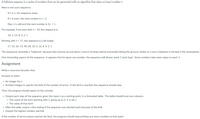
Computer Networking: A Top-Down Approach (7th Edition)
7th Edition
ISBN: 9780133594140
Author: James Kurose, Keith Ross
Publisher: PEARSON
expand_more
expand_more
format_list_bulleted
Question
C++

Transcribed Image Text:A hailstone sequence is a series of numbers that can be generated with an algorithm that takes an input number n.
Here is one such sequence:
If n is 1, the sequence stops.
If n is even, the next number is n / 2.
Else, n is odd and the next number is 3n + 1.
For example, if we start with n = 10, the sequence is:
10, 5, 16, 8, 4, 2, 1
Starting with n = 17, the sequence is a bit longer:
17, 52, 26, 13, 40, 20, 10, 5, 16, 8, 4, 2, 1
The sequences resemble a "hailstone" because they bounce up and down a bunch of times before eventually hitting the ground, similar to a way a hailstone is formed in the atmosphere.
One interesting aspect of this sequence: it appears that for given any number, the sequence will always reach 1 (and stop). Some numbers take many steps to reach 1.
Assignment
Write a recursive function that:
Accepts as input:
• An integer for n
• Another integer to specify the limit of the number of terms. If the limit is reached, the sequence should stop.
Then, the program should report to the console:
• Output each step of the sequence given the input n as a starting point, in a formatted table. The table should have two columns:
• The count of the term (starting with 1, going up as 2, 3, 4, etc.)
• The value of that term
• After the table, output a line stating if the sequence was aborted early because of the limit
Output the highest number reached
If the number of terms output reaches the limit, the program should stop printing any more numbers at that point.

Transcribed Image Text:Example Output (two separate runs)
Number: -8
Invalid number, please try again.
Number: 11
Limit of terms: 6
Term Number
Value
1
34
3
17
52
26
13
Sequence was aborted early.
Highest number reached: 52
Number: 12
Limit of terms: 30
Term Number
Value
12
6
3
10
16
8.
4
9
10
Highest number reached: 16
Expert Solution
This question has been solved!
Explore an expertly crafted, step-by-step solution for a thorough understanding of key concepts.
This is a popular solution
Trending nowThis is a popular solution!
Step by stepSolved in 2 steps with 2 images

Knowledge Booster
Similar questions
- Exercise 3: ● Comments in C++ are written with special characters. Insert the missing parts: How to Make this a single-line comment And Make this a multi-line comment SME Exarcica A:arrow_forwardQ2:C has many statements for decisions and loops, while MIPS has few. What are the pros and cons for having more or less decision/loop statements? Please give several detailed examples.arrow_forward
Recommended textbooks for you
 Computer Networking: A Top-Down Approach (7th Edi...Computer EngineeringISBN:9780133594140Author:James Kurose, Keith RossPublisher:PEARSON
Computer Networking: A Top-Down Approach (7th Edi...Computer EngineeringISBN:9780133594140Author:James Kurose, Keith RossPublisher:PEARSON Computer Organization and Design MIPS Edition, Fi...Computer EngineeringISBN:9780124077263Author:David A. Patterson, John L. HennessyPublisher:Elsevier Science
Computer Organization and Design MIPS Edition, Fi...Computer EngineeringISBN:9780124077263Author:David A. Patterson, John L. HennessyPublisher:Elsevier Science Network+ Guide to Networks (MindTap Course List)Computer EngineeringISBN:9781337569330Author:Jill West, Tamara Dean, Jean AndrewsPublisher:Cengage Learning
Network+ Guide to Networks (MindTap Course List)Computer EngineeringISBN:9781337569330Author:Jill West, Tamara Dean, Jean AndrewsPublisher:Cengage Learning Concepts of Database ManagementComputer EngineeringISBN:9781337093422Author:Joy L. Starks, Philip J. Pratt, Mary Z. LastPublisher:Cengage Learning
Concepts of Database ManagementComputer EngineeringISBN:9781337093422Author:Joy L. Starks, Philip J. Pratt, Mary Z. LastPublisher:Cengage Learning Prelude to ProgrammingComputer EngineeringISBN:9780133750423Author:VENIT, StewartPublisher:Pearson Education
Prelude to ProgrammingComputer EngineeringISBN:9780133750423Author:VENIT, StewartPublisher:Pearson Education Sc Business Data Communications and Networking, T...Computer EngineeringISBN:9781119368830Author:FITZGERALDPublisher:WILEY
Sc Business Data Communications and Networking, T...Computer EngineeringISBN:9781119368830Author:FITZGERALDPublisher:WILEY

Computer Networking: A Top-Down Approach (7th Edi...
Computer Engineering
ISBN:9780133594140
Author:James Kurose, Keith Ross
Publisher:PEARSON

Computer Organization and Design MIPS Edition, Fi...
Computer Engineering
ISBN:9780124077263
Author:David A. Patterson, John L. Hennessy
Publisher:Elsevier Science

Network+ Guide to Networks (MindTap Course List)
Computer Engineering
ISBN:9781337569330
Author:Jill West, Tamara Dean, Jean Andrews
Publisher:Cengage Learning

Concepts of Database Management
Computer Engineering
ISBN:9781337093422
Author:Joy L. Starks, Philip J. Pratt, Mary Z. Last
Publisher:Cengage Learning

Prelude to Programming
Computer Engineering
ISBN:9780133750423
Author:VENIT, Stewart
Publisher:Pearson Education

Sc Business Data Communications and Networking, T...
Computer Engineering
ISBN:9781119368830
Author:FITZGERALD
Publisher:WILEY